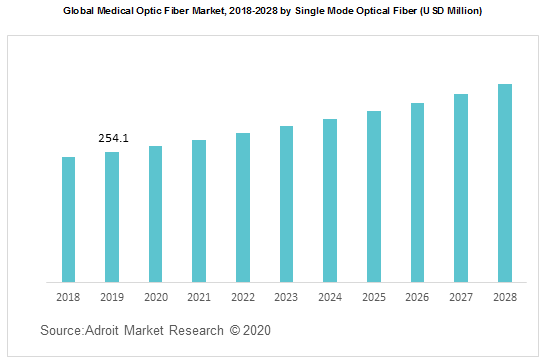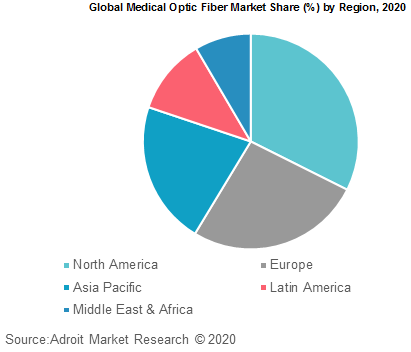The global medical optic fiber market was valued at USD 850.2 million in 2019 and is expected to grow at a CAGR of 5.6% over the forecast period.
The global Medical Fiber Optics market is expected to develop US$ 2.53 Bn by 2032, at a compound annual increase in price (CAGR) of 26% throughout the forecast period.
.jpg)
The key factors boosting the market are increasing the number of endoscopic procedures for early diagnosis of various cancers, increasing the adoption of technologically advanced products, and increasing awareness of minimally invasive surgery. The other factors that drive the demand are also the increasing use of lasers in dentistry and cosmetology and ongoing studies on biomedical sensors.
That being said, the high price of medical optical fiber is expected to hinder future growth to some extent at least over the forecast timeframe. As compared to several other cables, fiber optical cables have a larger market demand. Manufacturers, however are still manually producing components for medical fiber optics, such as lasers, amplifiers, audio amplifiers, connectors, and switches. During the manufacturing process, the modules often need several labour-intensive customizations and modifications. This further contributes to the overall production costs and makes them costly.
Key players serving the global market include Integra Lifesciences Corporation , Fiberoptics Technology Incorporated , AFL , Molex , COHERENT, INC , Timbercon, INC , Gulf Fiberoptics , Newport Corporation , SCHOTT , LEONI ,among other prominent players.
Medical Fiber Optics Market Scope
| Metrics | Details |
| Base Year | 2023 |
| Historic Data | 2018-2022 |
| Forecast Period | 2024-2032 |
| Study Period | 2018-2032 |
| Forecast Unit | Value (USD) |
| Revenue forecast in 2032 | US$ 2.53 Bn |
| Growth Rate | CAGR of 26% during 2022-2032 |
| Segment Covered | by Fiber Type, Regions |
| Regions Covered | North America, Europe, Asia Pacific, South America, Middle East and Africa |
| Key Players Profiled | SCHOTT, LEONI, Newport Corporation, Coherent Inc., Molex Incorporated, Integra LifeSciences Holdings Corporation, Fiberoptics Technology Incorporated, Timbercon |
Key Segment Of The Medical Fiber Optics Market
Fiber Type, (USD Billion)
o Pure Silica Fiber
• UV- Silica
• Near Infrared (NIR) Silica
• Metal- Coated Silica
• Plastic Clad Silica
o Thulium Doped Fiber Lasers (TDFLs)
o Holmium: YAG
o Step-Index Fiber
o Graded-Index Fiber
o Polycrystalline Fiber
o Polymer Optical
Mode, (USD Billion)
• Single Mode Fiber
• Multi-Mode Fiber
Usage, (USD Billion)
• Disposable Surgical Laser Fiber
• Reusable Surgical Laser Fiber
Type of Procedure, (USD Billion)
• Optical Coherence Tomography
• Brain Tumor Ablation
• Lipolysis
• Others
Application, (USD Billion)
• Power Delivery
• Imaging
• Sensing
• Others
Regional Overview, (USD Billion)
North America
• US
• Canada
Europe
• Germany
• France
• UK
• Rest of Europe
Asia Pacific
• China
• India
• Japan
• Rest of Asia Pacific
South America
• Mexico
• Brazil
• Rest of South America
Middle East and South Africa
Frequently Asked Questions (FAQ) :
The world's healthcare providers and consumers looking for advanced biomedical instrumentation to allow more efficient patient diagnosis, monitoring, and treatment with a global population that is both growing and living longer. In this sense, optical fiber biomedical sensors are of rising significance. At the same time, smaller disposable sensing catheters are required by recent advances in minimally invasive surgery (MIS). Fiber-optic endoscopic imaging applications are well known, but the inherent physical properties of optical fibers still make them particularly desirable for biomedical imaging.
A light source, an optical fiber, an external transducer, and a photodetector are optical fiber sensors. For eg, they feel by sensing the modulation of one or more of the light properties that are directed within the fiber, such as intensity, wavelength or polarization. In a specific and repeatable manner, the modulation is created by an external disturbance induced by the physical parameter to be calculated.
In addition, their poor penetration in developing and underdeveloped countries is also a significant business problem. These countries are spending less in preparing surgeons for the use of endoscopes and lasers, as the penetration of these devices in those countries is limited. Currently, this delays consumer expansion. In addition, players are hesitant to buy technological licences or intellectual property due to restrictions on funding and resources in these countries. This prevents them from using processes developed for the production of medical fiber optics that are more efficient.
The global medical optic fiber market has been bifurcated based on type, application and region. In terms of type, the market is divided into single mode optical fiber and multimode mode optical fiber. On the basis of application, the segment is divided into Endoscopic Imaging, Laser Signal Delivery, Biomedical Sensing, Illumination, and others.
In 2019, multimode optical fiber dominated the global market and is predicted to maintain its position over the study period. Compared to single mode fibers, this is due to the high use of multimode fibers. Multimode fibers are more affordable and simpler to produce, enhancing their rise in the industry further. On the other hand, during the forecast period, single mode optical fibers are anticipated to be the fastest growing market.
The key factors expected to boost the medical fiber optics industry over the forecast era are ongoing research and funding on biomedical optical sensors, expanded use of wearables and telemedicine, and the launch of technologically advanced fiber optics-based medical devices. By application, the largest category with a share of more than 30% in 2019 was illumination owing to rising number of endoscopic surgeries where fibers are used as a light source.

Based on regions, the global medical optic fiber market is segmented into North America, Europe, Asia Pacific, Central and South America And Middle East & Africa. Emerging markets such as APAC are giving companies major growth prospects in the demand for the Industry’s in coming years.
In 2019, North America dominated the global market. The main drivers supporting the demand are high penetration of technologically innovative devices such as endoscopes and lasers for conducting minimally invasive procedures, attractive reimbursement strategies, and the availability of well-developed healthcare infrastructure. In addition, the high prevalence of cancer and the need for innovative biomedical methods for improved diagnosis, surveillance and care of patients are also expected to push the market.
Furthermore, Asia Pacific is anticipated to emerge as the most lucrative region over the forecast period. Increasing demand from South Korea and japan owing to rise in digestive disorders in the countries coupled with high geriatric population prone to chronic conditions is anticipated to fuel the regional growth over the forecast period.


